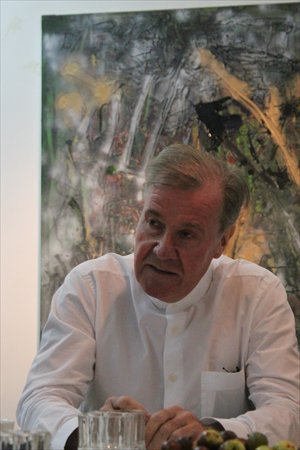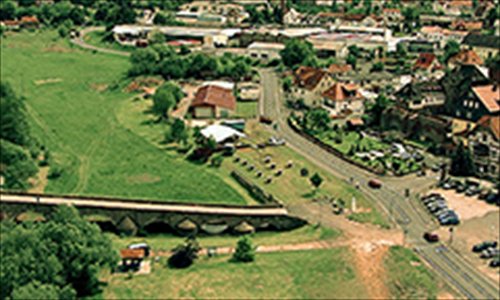Scars of the past
Experimental movie is a personal journey examining the Berlin Wall

Burkhard von Harder Photo: Xu Ming/GT

A scene from Narbe Deutschland Photo: Courtesy of the Being 3 Gallery
When looking at a piece of art work, we usually ask ourselves: What was going on in the mind of the artist when they created it? However, in the experimental film Narbe Deutschland (German Scar) by German artist Burkhard von Harder, what the audience thinks and feels is more important than the thoughts of its creator.
The 16-hour long film is all about the Berlin Wall and the huge barrier that once separated Germany from 1961 to 1989. Using a bird's eye view to follow where the wall used to exist, the film recalls Germany's past involvement with fascism and the Cold War as well as salve to help heal the scar that was left behind.
Filled with mixed personal feelings and the heaviness of history, the film, set to begin showing Saturday at the Being 3 Gallery in Beijing's 798 Art Zone, stresses the internal mental experience of the audience. For this reason, the film contains nearly no dialogue, providing no information so as to allow the audience to think and work through the emotions inspired by the soundtrack and images.
Show, don't tell
A symbol of the Cold War, the 156-kilometer-long Berlin Wall used to run through the country like a long knife cutting it in two. Now crumbled to pieces or in some places leaving no trace, it remains a scar representing a time that will stay forever in the memory of history.
Von Harder's intention is to use this work to heal this scar on both a personal and historic level.
From 2009 to 2013, with the support from Medienboard, von Harder flew in a helicopter over the path where the Berlin Wall used to stand and the previous 1,378 kilometer border that used to divide the country in order to gather footage for the film.
Von Harder starts the movie with a sound recording of Prussian statesman Otto von Bismarck from back in 1889 that was discovered just last year. In the recording, von Bismarck gives suggestions to his son on how to live a harmonious life. This short recording is the only form of narration appearing in the entire film.
"When the film starts, 100 years have passed. No one had listened to his advice… The silence of the film gives the audience space to think about what happened to Germany over the past 100 years," von Harder explained during a press conference at the gallery on Friday.
As the film progresses, the director's lens zooms in on the former boundary that ran through different parts of the country. The long journey covers all four seasons, from autumn to summer showing varied colors from plain and depressing black and white to the bright and warm reds and greens of nature.
Twenty-five years after the fall of the Berlin Wall, the previous demarcation line is barely visible anymore, particularly along patches of forests, but the images of remaining posts and the sound of original loudspeaker announcements from that time period that appear sometimes in the film is able to pull the audience back to this period of the Cold War.
The inspiring soundtrack that runs throughout the film adds much to the grand aerial photography and acts as a major pillar supporting the work. It is a type of music following in the style of religious music from Tibet that von Harder's step-brother Klaus Wiese composed himself.
"I have interest in Eastern philosophy. It was just a coincidence that my step-brother was engaged in music exploring Eastern ways of thinking. It is called drone music, and has no beginning or end, like the images in my film," he explained. "For me, it was awkward to use Eastern music for a German topic, but it gives perspective, hope and beauty to the film, which otherwise would be dark."
Healing and salvation
It may be simple to see the film as just a reflection on the history of Germany or the world at large, for the director himself, it is more about his complicated personal feelings that are related to that period of history.
Growing up in 1960s in West Germany, von Harder experienced a time when everyone chose to be silent about East Germany and the war. This blank part of his personal history inspired him to research his family and its history after his parents death.
"It [the film] is a process to reconstruct my memory of that time," he noted, adding that not only did the wall split the country at the time, it also split his family, as he had relatives living in East Germany.
This personal connection has influenced the film in other ways as well. The reason the film is 16 hours long stems from the 16-hour-trip he would have to make every summer from his mother's home in the south to his father's in the north after their divorce.
In this sense, the film is a personal work related to his family, but on another level it is also about the millions of families that were affected at that time. "It is about German history, and more," said von Harder pointing out there are still many other similar walls around the world.
"I was invited to show a short section of the film in Jinan, Shandong Province, last October and the curator said it would be interesting to show it [the entire film] in China, a country that has all kinds of walls. Now it's really here," said von Harder.
The film is scheduled to show at the gallery until December 7.